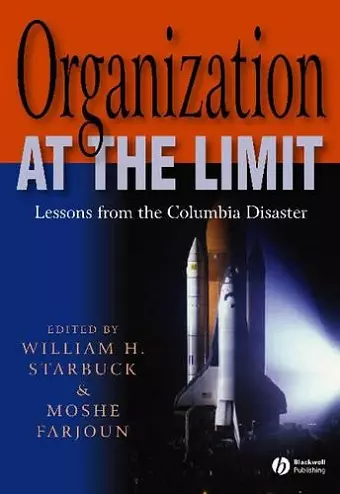Organization at the Limit
Lessons from the Columbia Disaster
William Starbuck editor Moshe Farjoun editor
Format:Hardback
Publisher:John Wiley and Sons Ltd
Published:18th Jul '05
Currently unavailable, and unfortunately no date known when it will be back

The book offers important insight relevant to Corporate, Government and Global organizations management in general. The internationally recognised authors tackle vital issues in decision making, how organizational risk is managed, how can technological and organizational complexities interact, what are the impediments for effective learning and how large, medium, and small organizations can, and in fact must, increase their resilience. Managers, organizational consultants, expert professionals, and training specialists; particularly those in high risk organizations, may find the issues covered in the book relevant to their daily work and a potential catalyst for thought and action.
- A timely analysis of the Columbia disaster and the organizational lessons that can be learned from it.
- Includes contributions from those involved in the Investigation Board report into the incident.
- Tackles vital issues such as the role of time pressures and goal conflict in decision making, and the impediments for effective learning.
- Examines how organizational risk is managed and how technological and organizational complexities interact.
- Assesses how large, medium, and small organizations can, and in fact must, increase their resilience.
- Questions our eagerness to embrace new technologies, yet reluctance to accept the risks of innovation.
- Offers a step by step understanding of the complex factors that led to disaster.
“The authors lift up the heavy curtain of secrecy at NASA to look at the many backstage decisions that led to the Columbia space shuttle disaster. Organizational leaders too often fail to learn from their past mistakes, but readers of this volume will be better equipped to understand and hopefully prevent future catastrophic failures.” Scott D. Sagan, Stanford University
“As the influential philosopher Karl Popper observed, to avoid perishing along with our false theories, we systematically try to eliminate our false theories, letting them die in our stead. The Columbia disaster is a stark and tragic lesson in the consequences of false theories. Using the Columbia disaster and NASA as its focal points, Organization at the Limit offers a rich, multifaceted examination that reveals how and why complex organizations using risky technologies often produce and sustain false theories. The analysis yields insights indispensable for those who wish to help such organizations unlearn their false theories, learn more truthful ones, and avoid the disasters that lurk beyond their limits.” Joel A. C. Baum, University of Toronto
“The Columbia disaster has much to teach any student and manager of organizations. In this marvellous collection, Professors Farjoun and Starbuck have assembled some of the most profound and relevant thinking about the hitherto hidden vulnerabilities of today’s organizations, their sources, and just how to address them. Readers will be most amply rewarded.” Danny Miller, HEC Montreal
“The CAIB report was the most sophisticated official examination of an accident ever. Now we have an exhaustive social science exploration which amplifies, extends, enriches, and even at times contradicts the Board’s analysis. A variety of theoretical perspectives are applied, generating many fresh insights.” Charles Perrow, Yale University
Howard Aldrich, Review on Amazon:
After two horrible disasters, do you think that NASA has learned from its mistakes, and that it will never happen again? If so, you need to read this book! In 18 well-written chapters, the editors have assembled a set of experts on organizations and disasters to analyze lessons from the Columbia disaster. Because the Challenger disaster foreshadowed many of the problems that subsequently turned up in official investigations of the Columbia disaster, it also figures heavily in this edited book. The authors demonstrate the analytic power of an historically informed organizational analysis of a large governmental agency under strong political pressure to produce results with limited resources.
Two points in particular caught my eye. First, after the Challenger disaster, NASA was supposedly reorganized to place greater emphasis on safety. However, because the organization began to define the space exploration program as a problem of meeting production goals and deadlines, "safety" never achieved the priority in the organization than it deserved. Instead of seeing the space shuttle program as a developmental one, exploring the risky frontier of technological knowledge, NASA officials treated it like any other flight program. Second, as anomalies continued to crop up after flights, engineers and officials began to think about deviations from acceptable practices and outcomes as "normal." As deviation was normalized, unusual events were taken for granted and didn't provoke the kind of response than one would expect from life threatening occurrences.
Scholars interested in organization studies, organizational learning, systems theory, and other academic disciplines will learn much from this book. However, one can also hope that public officials will take its lessons to heart and look more closely at the design of other risky systems that are operating close to the limits of our scientific knowledge. Amazon
ISBN: 9781405131087
Dimensions: 254mm x 178mm x 25mm
Weight: 980g
416 pages